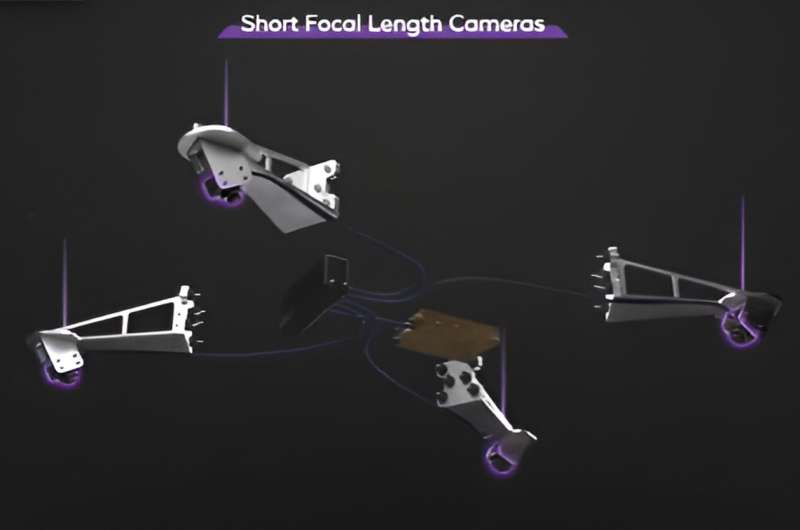This article has been reviewed according to Science X's editorial process and policies. Editors have highlighted the following attributes while ensuring the content's credibility:
fact-checked
trusted source
proofread
Tiny NASA cameras to picture interaction between lander, moon's surface

Say cheese, moon. We're coming in for a close-up. As Intuitive Machines' Nova-C lander descends toward the moon, four tiny NASA cameras will be trained on the lunar surface, collecting imagery of how the surface changes from interactions with the spacecraft's engine plume.
Developed at NASA's Langley Research Center in Hampton, Virginia, Stereo Cameras for Lunar Plume-Surface Studies (SCALPSS) is an array of cameras placed around the base of a lunar lander to collect imagery during and after descent. Using a technique called stereo photogrammetry, researchers at Langley will use the overlapping images from the version of SCALPSS on Nova-C—SCALPSS 1.0—to produce a 3D view of the surface.
These images of the moon's surface won't just be a "gee-whiz" novelty. As trips to the moon increase and the number of payloads touching down in proximity to one another grows, scientists and engineers need to be able to accurately predict the effects of landings.
How much will the surface change? As a lander comes down, what happens to the lunar soil, or regolith, it ejects? With limited data collected during descent and landing to date, SCALPSS will be the first dedicated instrument to measure plume-surface interaction on the moon in real time and help to answer these questions.
"If we're placing things —landers, habitats, etc.—near each other, we could be sand blasting what's next to us, so that's going to drive requirements on protecting those other assets on the surface, which could add mass, and that mass ripples through the architecture," said Michelle Munk, principal investigator for SCALPSS and acting chief architect for NASA's Space Technology Mission Directorate at NASA Headquarters. "It's all part of an integrated engineering problem."
Under Artemis, NASA intends to collaborate with commercial and international partners to establish the first long-term presence on the moon. On this Commercial Lunar Payload Services (CLPS) initiative delivery, SCALPSS 1.0 is purely focused on how the lander alters the surface of the moon during landing. It will begin capturing imagery from before the time the lander's plume begins interacting with the surface until after the landing is complete.
The final images will be gathered on a small onboard data storage unit before being sent to the lander for downlink back to Earth. The team will likely need at least a couple of months to process the images, verify the data, and generate the 3D digital elevation maps of the surface. The expected depression they reveal probably won't be very deep—not this time, anyway.
"Even if you look at the old Apollo images—and the Apollo crewed landers were larger than these new robotic landers—you have to look really closely to see where the erosion took place," said Rob Maddock, SCALPSS project manager at Langley. "We're anticipating something on the order of centimeters deep—maybe an inch. It really depends on the landing site and how deep the regolith is and where the bedrock is."
But this is a chance for researchers to see how well SCALPSS will work as the U.S. advances into a future where Human-Landing-Systems-class spacecraft will start making trips to the moon.
"Those are going to be much larger than even Apollo. Those are pretty large engines, and they could conceivably dig some good holes," said Maddock. "So that's what we're doing. We're collecting data we can use to validate the models that are predicting what will happen."
SCALPSS 1.1, which will feature two additional cameras, is scheduled to fly on another CLPS delivery—Firefly Aerospace's Blue Ghost—later this year. The extra cameras are optimized to take images at a higher altitude, prior to the expected onset of plume-surface interaction, and provide a more accurate before-and-after comparison.
NASA is working with several American companies to deliver science and technology to the lunar surface through the CLPS initiative.
These companies, ranging in size, bid on delivering payloads for NASA. This includes everything from payload integration and operations, to launching from Earth and landing on the surface of the moon.
Provided by NASA





















